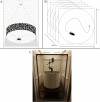Predicting movement speed of beetles from body size and temperature
- PMID: 37194049
- PMCID: PMC10189998
- DOI: 10.1186/s40462-023-00389-y
Predicting movement speed of beetles from body size and temperature
Abstract
Movement facilitates and alters species interactions, the resulting food web structures, species distribution patterns, community structures and survival of populations and communities. In the light of global change, it is crucial to gain a general understanding of how movement depends on traits and environmental conditions. Although insects and notably Coleoptera represent the largest and a functionally important taxonomic group, we still know little about their general movement capacities and how they respond to warming. Here, we measured the exploratory speed of 125 individuals of eight carabid beetle species across different temperatures and body masses using automated image-based tracking. The resulting data revealed a power-law scaling relationship of average movement speed with body mass. By additionally fitting a thermal performance curve to the data, we accounted for the unimodal temperature response of movement speed. Thereby, we yielded a general allometric and thermodynamic equation to predict exploratory speed from temperature and body mass. This equation predicting temperature-dependent movement speed can be incorporated into modeling approaches to predict trophic interactions or spatial movement patterns. Overall, these findings will help improve our understanding of how temperature effects on movement cascade from small to large spatial scales as well as from individual to population fitness and survival across communities.
Keywords: Allometry; Climate warming; Ectotherms; Exploratory speed; Image-based tracking; Movement ecology; Thermal response.
© 2023. The Author(s).
Conflict of interest statement
The authors declare that they have no competing interests.
Figures



References
-
- Angilletta MJ. Estimating and comparing thermal performance curves. J Therm Biol. 2006;31(7):541–545. doi: 10.1016/j.jtherbio.2006.06.002. - DOI
-
- Angilletta MJ, Roth TC, II, Wilson RS, Niehaus AC, Ribeiro PL. The fast and the fractalous: speed and tortuosity trade off in running ants. Funct Ecol. 2007;22:78–83. doi: 10.1111/j.1365-2435.2007.01348.x. - DOI
-
- Baguette M, Stevens VM, Clobert J. The pros and cons of applying the movement ecology paradigm for studying animal dispersal. Mov Ecol. 2014;2(1):13. doi: 10.1186/s40462-014-0013-6. - DOI

